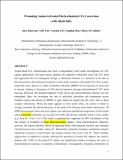| dc.contributor.author | Khurram, Aliza | |
| dc.contributor.author | Gallant, Betar M. (Betar Maurkah) | |
| dc.date.accessioned | 2020-10-15T19:53:40Z | |
| dc.date.available | 2020-10-15T19:53:40Z | |
| dc.date.issued | 2019-06 | |
| dc.identifier.issn | 1932-7447 | |
| dc.identifier.uri | https://hdl.handle.net/1721.1/128009 | |
| dc.description.abstract | Amine-based CO₂ chemisorption has been a long-standing motif under development for CO₂ capture applications, but large-energy penalties are required to thermally cleave the N-C bond and regenerate CO₂ for subsequent storage or utilization. Instead, it is attractive to be able to directly perform electrochemical reactions on the amine solutions with loaded CO₂. We recently found that such a process is viable in dimethyl sulfoxide (DMSO) if an exogenous Li-based salt is present, leading to the formation of CO₂-derived products through electrochemical N-C bond cleavage. However, the detailed influence of the salt on the electrochemical reactions was not understood. Here, we investigate the role of individual electrolyte salt constituents across multiple cations and anions in DMSO to gain improved insight into the salt's role in these complex electrolytes. Although the anion appears to have minor effect, the cation is found to strongly modulate the thermochemistry of the amine-CO₂ adducts through electrostatic interactions: 1H NMR measurements show that post-capture, pre-reduction equilibrium proportions of the formed cation-associated carbamate vary by up to 5-fold and increase with the cation's Lewis acidity (e.g., from K+ → Na+ → Li+). This trend is quantitatively supported by density functional theory calculations of the free energy of formation of the alkali-associated adducts. Upon electrochemical reduction, however, the current densities follow an opposing trend, with enhanced reaction rates obtained with the lowest Lewis-acidity cation, K+. Meanwhile, molecular dynamics simulations indicate significant increases in desolvation and pairing kinetics occur with K+. These findings suggest that in addition to strongly affecting the speciation of amine-CO₂ adducts, the cation's pairing with-COO- can significantly hinder or enhance the rates of electrochemical reactions. Consequently, designing electrolytes to promote fast cation transfer appears important for obtaining higher current densities in future systems. | en_US |
| dc.description.sponsorship | National Science Foundation (U.S.) (Award DMR 14-19807) | en_US |
| dc.description.sponsorship | National Science Foundation (U.S.) (Grant ACI-1548562) | en_US |
| dc.language.iso | en | |
| dc.publisher | American Chemical Society (ACS) | en_US |
| dc.relation.isversionof | http://dx.doi.org/10.1021/ACS.JPCC.9B04258 | en_US |
| dc.rights | Article is made available in accordance with the publisher's policy and may be subject to US copyright law. Please refer to the publisher's site for terms of use. | en_US |
| dc.source | Prof. Gallant via Elizabeth Soergel | en_US |
| dc.title | Promoting Amine-Activated Electrochemical CO₂ Conversion with Alkali Salts | en_US |
| dc.type | Article | en_US |
| dc.identifier.citation | Khurram, Aliza et al. “Promoting Amine-Activated Electrochemical CO₂ Conversion with Alkali Salts.” Journal of Physical Chemistry C, 123, 30 (June 2019): 18222–18231 © 2019 The Author(s) | en_US |
| dc.contributor.department | Massachusetts Institute of Technology. Department of Mechanical Engineering | en_US |
| dc.contributor.department | Massachusetts Institute of Technology. Institute for Data, Systems, and Society | en_US |
| dc.relation.journal | Journal of Physical Chemistry C | en_US |
| dc.eprint.version | Author's final manuscript | en_US |
| dc.type.uri | http://purl.org/eprint/type/JournalArticle | en_US |
| eprint.status | http://purl.org/eprint/status/PeerReviewed | en_US |
| dc.date.updated | 2020-09-30T13:52:38Z | |
| dspace.orderedauthors | Khurram, A; Yan, L; Yin, Y; Zhao, L; Gallant, BM | en_US |
| dspace.date.submission | 2020-09-30T13:52:43Z | |
| mit.journal.volume | 123 | en_US |
| mit.journal.issue | 30 | en_US |
| mit.license | PUBLISHER_POLICY | |
| mit.metadata.status | Complete | |
